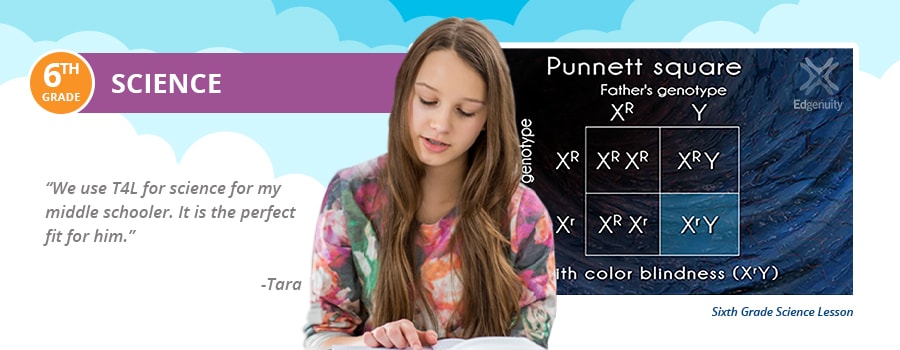Sixth Grade Science Curriculum
What should a 6th grader know in science? If you’re trying to find the answer to that question, you’ve come to the right place. This page includes information on what a sixth grade science curriculum should include, objectives for sixth grade science, information on how Time4Learning can help your child meet those objectives and make science fun.
What Do You Teach in Science in 6th Grade?
Time4Learning sixth grade science students have three course options to choose from. Although there is no specific sequence to follow, life science is usually the recommended course for sixth graders. However, Time4Learning members are able to select a different middle school science course for their student if they choose.
Below are the middle school science courses available to Time4Learning members.
Learn more about Time4Learning’s sixth grade science curriculum by checking out the 6th grade science lesson plans below.
Science Objectives for Sixth Grade
At the end of the year, sixth grade science students should have achieved a number of objectives for the year. It’s important to find out what your state’s homeschool requirements are when it comes to sixth grade science. Typically, you’ll find that science objectives for sixth grade include:
- Distinguish between variables and controls in a scientific investigation
- Analyze data to determine validity and reliability
- Explain the steps of photosynthesis
- Identify the components and structure of DNA
- Explain how scientists determine the age of a fossil
Time4Learning 6th Grade Life Science Lesson Plans
- Scientific Knowledge
- Scientific Inquiry
- Hypotheses, Theories, and Laws
- Measurement
- Analyzing Data
- Characteristics of Life
- Building Blocks of Life
- Introduction to Classification
- Classification of Living Things
- Dichotomous Keys
- Lab: Dichotomous Keys
- Cell Theory
- Cell Structure
- Animal and Plant Cells
- Lab: Exploring Cells
- Photosynthesis
- Cellular Respiration
- Cell Cycle
- Meiosis
- Asexual and Sexual Reproduction
- Genetic Code
- DNA Mutations
- Introduction to Heredity
- Predicting Heredity
- Inheritance Patterns
- Lab: Heredity and Punnett Squares
- Advances in Genetics
- The Theory of Evolution
- Natural Selection
- Lab: Natural Selection
- The Fossil Record
- Evidence for Evolution
- Evolutionary Relationships
- Cumulative Exam
- Bacteria
- Protists
- Fungi
- Overview of Plants
- Seedless Plants
- Gymnosperms
- Angiosperms
- Lab: Flower Dissection
- Sponges and Cnidarians
- Worms
- Mollusks and Echinoderms
- Arthropods
- Fish
- Amphibians and Reptiles
- Birds and Mammals
- Animal Behavior
- Lab: Earthworm Behavior
- Body Organization and Homeostasis
- The Musculoskeletal and Integumentary Systems
- The Digestive and Excretory Systems
- The Circulatory and Respiratory Systems
- The Immune System
- The Nervous and Endocrine Systems
- The Reproductive Systems
- Living Things and the Environment
- Populations
- Interactions among Living Things
- Energy Flow in Ecosystems
- Lab: Owl Pellets
- Cycles of Matter
- Biomes
- Succession
- Lab: Ecological Succession
- Natural Environmental Change
- Human Impact on the Environment
- Biodiversity
- Cumulative Exam
Why Choose Time4Learning Sixth Grade Science Homeschool Curriculum
The Time4Learning sixth grade science curriculum not only makes learning science fun, but it also helps your child achieve each of the objectives mentioned above and more. The interactive, comprehensive curriculum teaches through the use of engaging video lessons led by experienced teachers that help students gain a thorough understanding of the material. Keep in mind that although Time4Learning assigns life science to sixth grade students, parents have the option to choose another one of our middle school science courses.
Learn more about our online sixth grade curriculum, designed to help your child learn and master their fundamental concepts.






